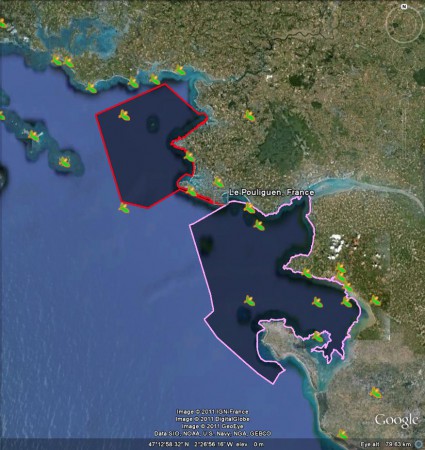- German donor examines food and security, notes “the fast loss of biodiversity”.
- Food carts are successful oases in at least one food “desert”.
- Yesterday’s Botany Photo of the Day was American cotton.
- Good news, everyone: “Hardcore farmers prefer lowkey rituals.” Obviously the memo didn’t reach the children of the corn.
- Photosynthesis and climate change: it’s complicated.
- Native Americans try to reclaim control of their foodways. And their waists.
- “…every district should have a community-controlled seed centre with a gene bank for traditional seeds.” Of course it should. “The local available seed diversity needs to be protected and conserved at any cost.” Of course it must.
- “Right now, all over the world, projects are underway to store seeds…“
- Dark earths not just in Amazon, Africa too.
- Presentation on IFAD project on cultivating wild aromatic etc. species for money in Morocco.
Protecting PI 198758 and its neighbours
Can’t resist a little follow-up to Jeremy’s biographical sketch of PI 198758, which as you’ll remember is a wild beet which hails from Le Pouliguen in France and has some coveted nematode resistance or other. If you look for the taxon in question (B. vulgaris subsp. maritima, and variations thereof) in GBIF, you get quite a few hits around the area of Le Pouliguen, which is in the Loire. And if you check that general region on Natura 2000 you realize that a lot of that coast is protected, whether under the Habitats Directive or the Birds Directive or whatever.
The question, of course, is whether the managers of such protected areas as Mor Braz (that’s the northern polygon on the map) and the Estuaire de la Loire Nord (the southern polygon) are aware of this or any other crop wild relative that may chance to occur in their charges. I suspect that even if you told them, alas, they would not much care. And yes, I know that some of those records seem to fall in the sea. Take it up with the Service du Patrimoine naturel, Muséum national d’Histoire naturelle, who provided the original data to GBIF.
Nibbles: Royal genebank, Fish collection, Plant health, USDA wheat breeding project, Afghanistan, Breadfruit Art, Pests and Diseases, Idaho, Plant breeding, Gates, Panax quinquefolius, Natives
- Thai king has crop genebank on palace grounds.
- Fish in jars.
- Planning Plant Clinics.
- Plant Breeding for Drought Stress: The Project.
- Wait, the Nebraska National Guard has an agribusiness development team? Maybe they should talk to the people responsible for the previous bullet point?
- Kids! (And adults!) An Art Contest to celebrate ‘Ulu. Breadfruit, that is.
- Use of Agrobiodiversity for Pest and Disease Management. A slide show from Carlo Fadda at Bioversity.
- 3rd Annual Biodiversity Working for Farmers Tour in Idaho. 23rd June, you have been warned.
- Huge New York Times story on plant breeding and climate change.
- Bill Gates hails creativity for small farmers challenge.
- American ginseng: use it or lose it.
- Do you live in Ann Arbour? Do you want native plants for your garden? Yeah but how about American ginseng?
Brainfood: Baby’s veggies, Chickpea and drought, Vine cactus breeding, Paleolithic rabbits, California protected areas, Wild pigeonpea, Pecorino classification, Milk composition, Phenotyping, Wild peas
- Vegetables by Stealth: an exploratory study investigating the introduction of vegetables in the weaning period. Sneaking them into the diet is the most common strategy used by mothers to introduce their kids to vegetables. Reeeeeally?
- Assessment of Iranian chickpea (Cicer arietinum L.) germplasms for drought tolerance. Four out of 150 local landraces showed promise. It really is a numbers game, isn’t it?
- In situ induction of chromosome doubling in vine cacti (Cactaceae). Potentially valuable autopolyploids were produced. Not that it was easy or anything.
- Who brought in the rabbits? Taphonomical analysis of Mousterian and Solutrean leporid accumulations from Gruta Do Caldeirão (Tomar, Portugal). People did, that’s who, but only during the later Upper Paleolithic. Before that it was mainly owls.
- Protected areas in climate space: What will the future bring? Nothing good. Both novel and disappearing climates are over-represented in current protected areas, at least in California.
- Progress in the utilization of Cajanus platycarpus (Benth.) Maesen in pigeonpea improvement. Baby steps.
- Classification of pecorino cheeses using electronic nose combined with artificial neural network and comparison with GC-MS analysis of volatile compounds. Wait, there are different kinds of pecorino?
- The need for country specific composition data on milk. Well, you’ve got me convinced.
- Rate-distortion tradeoff to optimize high-throughput phenotyping systems. Application to X-ray images of seeds. So, let me get this straight, basically, gauging the optimal trade-off between speed and accuracy in high-throughput phenotyping systems depends on what you’re measuring? Who writes these grant applications?
- Experimental growing of wild pea in Israel and its bearing on Near Eastern plant domestication. First pea growers were either very patient or very quick workers.
Nibbles: Tamil genebank, Econutrition, Sweet perception, Salmon, Texas culinary diversity, Amaranth, Nepal hermarium video, Restoration
- Provincial Indian university gets a genebank.
- Nutritionists go all ecological on us.
- But does that include taking into account human variation in taste perception? I’m betting no.
- The case against GM salmon.
- Going crazy in Austin’s market.
- Amaranth touted in Kenya. Sorghum and local millets unavailable for comment.
- Take a virtual trip around Nepal’s herbarium.
- Society for Ecological Restoration opens online Early Registration for the 4th World Conference on Ecological Restoration, to be held in August in Mérida, Mexico. You guys need a blogger?
